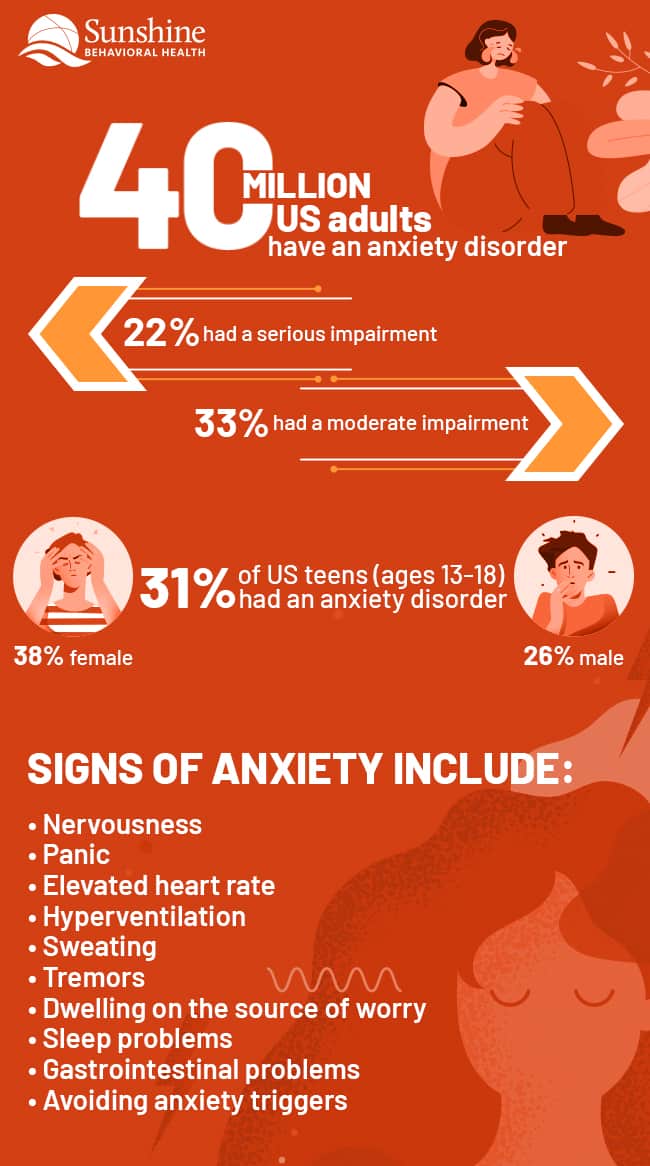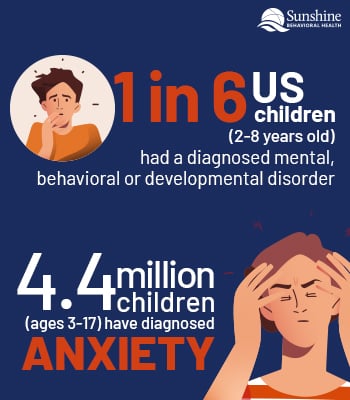It’s estimated that nearly one in five American adults have some sort of anxiety disorder.
Not only can such conditions harm a person’s mental and physical health, but it’s not unusual for anxiety disorders to co-occur with substance use disorders (SUD). One study estimated nearly 18% of respondents with a current SUD also had an anxiety disorder.
Anxiety isn’t all bad. It’s normal, in fact, and can help us focus or navigate an emergency situation. But when it overtakes one’s life, it can quickly turn problematic. It’s important to know what is ordinary, but it’s also vital to understand when it might be time to seek help.
What Is Normal Anxiety?
Some people may wonder if what they’re experiencing is simply a mild case of worry or if it’s something worse.
Worry and anxiety are related, and sometimes used interchangeably, but there are differences.
Worry is just one part of anxiety.
Usually, anxiety has three main elements: emotional, physiological, and cognitive. Before a speech or a test, for example, a person may feel fear or apprehension. That’s emotional. Their stomach may feel a bit uneasy. That’s physiological. They may think “I’ll make a huge mistake” or “I’ll forget what I need to do or know.” That’s cognitive.
A person may feel nervous, but they’ll power through in spite of a bit of fear. A bit of anxiety is considered normal, in fact.
What Are Anxiety Disorders?
An anxiety disorder occurs when someone feels a severe and lingering worry that’s excessive for the situation. Normal anxiety will pass once the event is over.
Anxiety becomes a problem when it’s severe enough to interfere with everyday functioning, and the fear does not go away.
 The symptoms then can affect job performance, school work, relationships, and more. A person who has a panic attack and calls in sick for much of the week, they may have an anxiety disorder.
The symptoms then can affect job performance, school work, relationships, and more. A person who has a panic attack and calls in sick for much of the week, they may have an anxiety disorder.
When there’s an anxiety disorder, the fear does not go away, and it’ll be out of proportion to the actual danger.
Signs of anxiety include:
- Nervousness
- Panic
- Elevated heart rate
- Hyperventilation
- Sweating
- Tremors
- Dwelling on the source of worry
- Sleep problems
- Gastrointestinal problems
- Avoiding anxiety triggers
The symptoms, left untreated, tend to grow worse over time.
Kinds of Anxiety Disorders
There are several kinds of anxiety disorders, too. They vary due to the objects or occurrences that trigger them, but they all are characterized by excessive worry and interfere with day-to-day functioning.
A person can have more than one anxiety disorder.
Common disorders include:
- Panic disorder. Frequent or unexpected panic attacks. They can occur randomly or be brought on by a triggering event or object.
- Generalized anxiety disorder (GAD). Excess anxiety most of the time for at least six months, often about everyday things.
- Agoraphobia. Fear of two or more of the following: Using public transportation, being in open or enclosed areas, being in a crowd, or venturing outside the home alone.
- Specific phobias. Intense fear of specific objects and situations, like flying, heights, snakes, or injections. They may go out of their way to avoid the item or situation, and panic when confronting or even considering it.
- Social anxiety disorder/social phobia. Intense fear of social or performance situations. They dread judgment and embarrassment and may avoid interacting with others.
- Post-traumatic stress disorder. Occurs after experiencing or witnessing a terrifying event that caused or threatened great harm. It can include military combat, accidents, personal assaults, or disasters.
- Obsessive-compulsive disorder. Recurring and unwelcome thoughts (obsessions) and repetitive behaviors (compulsions). Repeat hand washing, cleaning, or counting are three examples of rituals aimed to alleviate panic.
- Separation anxiety. Not just affecting children, but adults with the disorder may fear being separated from those to whom they are attached. Usually, they worry something bad will happen to that person when they are apart.
What Causes Anxiety Disorders?
The exact cause of anxiety isn’t exactly clear. Both genetics and environmental factors can elevate the likelihood of developing an anxiety disorder.
Potential contributors include:
- Personality type, including shyness or reticence during childhood.
- Traumatic, stressful, or negative events, especially during childhood or early adulthood. A person can experience trauma or witness it.
- Family history of anxiety or mental illness, especially among close biological relatives.
- Mental health disorders like depression or substance use disorders.
- Health issues, like thyroid or heart problems. Anxiety can develop as a side effect of medication or other substances.
How Does Anxiety Affect Us?
Normal anxiety tends to be on the milder side: A bit of apprehension, sweaty palms, or slight nervousness about getting through something. It won’t get in the way of day-to-day functioning. In fact, it can actually help a person focus. Being a bit nervous about an exam, for example, can motivate a person to study and prepare.
When anxiety goes into overdrive, however, it can lead to a number of complications that can turn downright disruptive as time goes on.
Anxiety and Physical Health
 Physically, anxiety can lead to:
Physically, anxiety can lead to:
- Insomnia
- Digestive troubles
- Headaches
- Chronic pain
- Heart palpitations
Over the long term, poor sleep can lead to a lack of focus, tiredness, and slowed reaction times when driving or doing work.
Digestive problems can lead to ulcers.
Headaches and pain may lead a person to rely on medications to get through the day, and long-term painkillers–even something seemingly as mild as acetaminophen–can tax the kidneys and liver. Stronger drugs and substances can lead to addiction.
Stress can also contribute to high blood pressure and heart disease.
Anxiety and Mental Health
Anxiety has been linked to a number of mental health conditions, and can sometimes make them worse. Anxiety can lead to or result from:
- Depression
- Substance use
- Social isolation
- Attention Deficit Hyperactivity Disorder (ADHD)
- Eating disorders
- Trouble focusing on work, school, or at home
- A decreased quality of life
- Suicide
Anxiety and Addiction
Anxiety disorders and substance use disorders do often co-occur. (When an individual has both a mental disorder and a substance use disorder, that’s called a dual diagnosis.)
Generalized anxiety disorder, panic disorder, and PTSD have been linked to substance use disorder. Sometimes a person may resort to alcohol and drugs to self-medicate an undiagnosed mental disorder.
In other situations, a person may develop anxiety or an anxiety disorder as a result of drug or alcohol misuse.
When asking if anxiety more commonly leads to addiction, or if addiction more frequently leads to anxiety, it’s difficult to say.
Anxiety may happen because a person has become dependent on a substance and is experiencing withdrawal if they run out or try to quit without help. It may also be a side effect of some drugs.
Methamphetamine, for example, can cause anxiety when a user quits taking it, but long-term use can also produce anxiety.
Biology, personal history, the substances used as well as at what age — these and more can play into whether a person develops a substance use disorder or not. They can also play a part in anxiety disorders.
Many of the risk factors for mental disorders, be it anxiety or something else, and substance use disorders are the same.
Signs of Addiction
Knowing the signs of a substance use disorder is the first step toward getting help, either for yourself or a loved one. Behaviors will change, and so might a person’s appearance. Signs of a problem include:
- Skipping work or school
- Getting into trouble (legal problems, money issues)
- Risky behaviors (like driving under the influence)
- Personality changes, mood swings
- Being hyper or paranoid
- Acting agitated or hyper
- Slurred speech, impaired coordination
- New friends or hangouts
Usually, if a person keeps using despite the problems it causes their social, family, work, or school life; they experience withdrawal or develop a tolerance to the substance in question; or they try to quit but can’t, those are signs of a substance use disorder.
How to Manage Anxiety
When anxiety rears its head, there are steps a person can take to feel better:
- Pause. Stop for a moment and note what’s happening. Did something stressful happen?
- Distract. This can be helpful, as it pulls your attention away from the anxiety. Focusing on something else — a walk, a hobby, a small chore — for a time may make you feel better.
- Relax. Deep breathing or relaxation techniques can ease anxiety.
- Exercise. Physical activity can burn off some tension, and it’s good for you.
- Reassure yourself. Remind yourself the anxiety is fleeting and you’re not really in danger. Sometimes realizing that can be enough.
- Get a checkup. Find out if it’s anxiety that sparks a physical symptom, or vice-versa. An allergy attack, for example, may create anxiety, but anxiety also may create shortness of breath.
- Get help. Some anxiety is normal, but if it’s interfering with your life in some significant ways, it may be time to see your doctor or mental health professional.
Treatment is also an option for anxiety disorders. Meditation and stress management can help. So can counseling and therapy.
Treating Anxiety and Addiction
Sometimes anxiety and addiction are treated in similar ways. A screening by a mental health or medical professional is a good beginning.
Talk therapy may address the root causes and handle triggers.
Cognitive-behavioral therapy is a popular form of treatment for anxiety and addiction, or both, when they co-occur. It can work quickly (being effective in a matter of weeks rather than years). The patient works with the therapist to understand the problem, the symptoms are evaluated, and a treatment plan and goals are set. The patient learns about negative thought patterns that contribute to the issue and works on new approaches to avoid and rein in anxiety. The patient will also learn new coping mechanisms that are healthier and more productive.
Exposure therapy, which is a part of cognitive-behavioral therapy, may be used, too, especially for anxiety. A person who is afraid of dogs, for example, may first discuss dogs, then look at photos of canines, observe dogs from across the room, and work toward petting a dog. The process causes the person to become more familiar with the fear or situation, and the feared object or situation loses its power to instill terror.
Medications can handle anxiety, but they can also help manage withdrawal and prevent relapse, in the case of substance use disorders (particularly medication-assisted therapy (MAT).
Medications that may help include:
- Antidepressants: There are many antidepressant options. Each one works a bit differently so when your doctor is deciding on the right one they’ll consider symptoms, potential side effects, what other medications you are taking, and other conditions you may have. Not only can they treat depression, which may be a factor in substance use disorders, but some may help with anxiety.
- Benzodiazepines: These medications (like Xanax or Valium) primarily are prescribed for anxiety but in different ways. Some may be used to help treat insomnia that results from anxiety, but others might alleviate the anxiety itself. In cases of substance use disorders, they can also help with the side effects of withdrawal (also insomnia and anxiety). Generally, because benzodiazepines tend to be habit-forming, they’re only prescribed for a limited amount of time, and then their dosage tapered to the patient can wean off them safely.
- Buspirone: This is another anti-anxiety medication (brand name BuSpar), but it’s not related to other sedatives like benzodiazepines or barbiturates. Buspirone is approved to treat generalized anxiety disorder. It’s also sometimes used off-label to treat PTSD and some withdrawal symptoms linked to heroin or opioid addiction.
- Beta-blockers are often used for high blood pressure but they can help some of the physical symptoms of anxiety like a rapid heartbeat, shaking, trembling, and blushing. They may be taken for a short time to keep the symptoms managed, or used as needed. Off-label, sometimes beta-blockers are prescribed to help with the anxiety that develops once drug or alcohol withdrawal sets in.
Finding Help for Anxiety and Addiction
Because substance use disorders and anxiety are commonly linked, with one potentially fueling the other, resources may address both substance use disorders and mental health. Some places to find help and information include:
- Substance Use Disorder and Mental Health Services Administration (SAMHSA). This government agency addresses both mental health and substance use disorder. Site visitors can read up on disorders and search for help. It also has a confidential national helpline, 800-662-HELP (4357), and an online treatment locator.
- MentalHealth.gov. This site is overseen by the U.S. Department of Health & Human Services. It has information about disorders, signs of problems, and tips for finding help.
- National Alliance on Mental Illness (NAMI). This national grassroots mental health organization aims to help Americans affected by mental illness. It has warning signs and symptoms, treatment resources, support groups, and more. They have a helpline, too: 800-950-6264, or text “NAMI” to 741741.
- Anxiety & Depression Association of America. This site offers information and links for specific demographics and on mental health in general.
- National Institute of Mental Health. Resources (including shareable ones) on anxiety disorders, links to helpful sites, information on studies, and more.
If you’re in crisis, consider:
- National Suicide Prevention Lifeline. 800-273-8255 (TALK).
Sources
Medical disclaimer:
Sunshine Behavioral Health strives to help people who are facing substance abuse, addiction, mental health disorders, or a combination of these conditions. It does this by providing compassionate care and evidence-based content that addresses health, treatment, and recovery.
Licensed medical professionals review material we publish on our site. The material is not a substitute for qualified medical diagnoses, treatment, or advice. It should not be used to replace the suggestions of your personal physician or other health care professionals.







